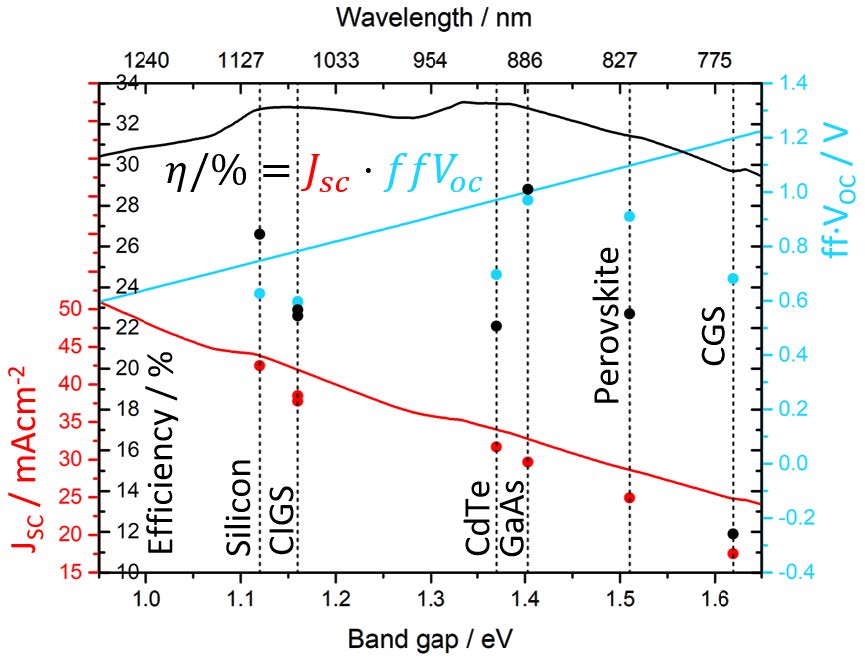The photovoltaic (PV) market has long been dominated by crystalline silicon-based technologies. Their success is rooted also in the laboratory, with record efficiencies ultimately approaching the theoretical limit for monocrystalline silicon. Market competitors are CdTe and Cu(In,Ga)(S,Se)2 (CIGS or chalcopyrite) thin films. Currently, the attractiveness of CIGS is curtailed by the module efficiency gap, with respect to silicon. Overcoming the gap requires the pursuit of strategic approaches, leaving plenty of room for research at both industrial and laboratory scale. Progress on the material poses compelling scientific challenges on the path to Shockley-Queisser parity. This contribution outlines the large opportunities offered by a concerted effort on wide-gap chalcopyrite (Figure). Here, insights are drawn from recent and older (but crucial) literature on narrow-gap chalcopyrite with the ambition to fully unlock the potential of the technology and afford efficient dual junction chalcopyrite devices.

Figure (a) Values of record efficiency solar cells based on silicon 2, CIGS (SF 3,4 and ZSW 5), GaAs 6, CdTe 7,8 and perovskite 9,10 with respect to the SQ theoretical limit (black curve). (b) The efficiency values are divided into optical (red left ordinate) and carrier management (right blue ordinate) contributions, respectively. Whenever possible, the bandgap values are extracted linearly from the quantum efficiency spectra, corresponding to the absorbers’ radiative recombination (for CdTe the value is substantially lower than 1.45 eV, due to Se alloying 11,12).
Bibliography
1. Colombara, D., Conley, K., Malitckaya, M., Komsa, H.-P. & Puska, M. J. The fox and the hound: in-depth and in-grain Na doping and Ga grading in Cu(In,Ga)Se2 solar cells. J. Mater. Chem. A 8, 6471–6479 (2020).
2. Yoshikawa, K. et al. Silicon heterojunction solar cell with interdigitated back contacts for a photoconversion efficiency over 26%. Nat. Energy 2, 17032 (2017).
3. Wu, J.-L., Hirai, Y., Kato, T., Sugimoto, H. & Bermudez, V. New World Record Efficiency up to 22.9% for Cu(In,Ga)(Se,S)2 Thin-Film Solar Cells. in (IEEE Journal of Photovoltaics, 2018).
4. Solar Frontier Achieves World Record Thin-Film Solar Cell Efficiency of 23.35%. http://www.solar-frontier.com/eng/news/2019/0117_press.html (2019).
5. Jackson, P. et al. Effects of heavy alkali elements in Cu(In,Ga)Se2 solar cells with efficiencies up to 22.6%. Phys. Status Solidi RRL – Rapid Res. Lett. 10, 583–586 (2016).
6. Kayes, B. M. et al. 27.6% Conversion efficiency, a new record for single-junction solar cells under 1 sun illumination. in 2011 37th IEEE Photovoltaic Specialists Conference 000004–000008 (2011).
7. Green, M. A., Emery, K., Hishikawa, Y., Warta, W. & Dunlop, E. D. Solar cell efficiency tables (version 48). Prog. Photovolt. Res. Appl. 24, 905–913 (2016).
8. Green, M. A., Emery, K., Hishikawa, Y., Warta, W. & Dunlop, E. D. Solar cell efficiency tables (version 46). Prog. Photovolt. Res. Appl. 23, 805–812 (2015).
9. Green, M. A. et al. Solar cell efficiency tables (version 51). Prog. Photovolt. Res. Appl. 26, 3–12 (2018).
10. Yang, W. S. et al. Iodide management in formamidinium-lead-halide–based perovskite layers for efficient solar cells. Science 356, 1376–1379 (2017).
11. Duggal, A. R., Shiang, J. J., Huber, W. H. & Halverson, A. F. Photovoltaic devices. (2014).
12. Poplawsky, J. D. et al. Structural and compositional dependence of the CdTexSe1−x alloy layer photoactivity in CdTe-based solar cells. Nat. Commun. 7, 12537 (2016).






